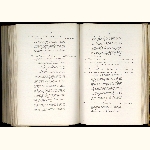Details of exhibit
- Exhibition:
- 1908 Fifty-third Annual Exhibition of the Royal Photographic Society of Great Britain
- Exhibit title:
- The Song Thrush
- Exhibitor:
- W. Farren
- Section:
- Scientific and Technical Photography and its Application to Processes of Reproduction
- Exhibit No.:
- 323
- Description:
- Illustrating the rapid growth of the young birds, the attitudes assumed by them whilst being fed and by the parents while delivering the food.
Date of hatching
May 7th
First photographs taken, showing nestling at three days, Nos. 1 to 5
May 10th
Nos. 6 to 8, showing nestling at 6 days, taken
May 13th
Nos. 9 to 14, showing nestling at 9 days, taken
May 16th
Nestling first left the nest on May 19th at the age of 12 days.
On the morning of May 10th, when the first five photographs were taken, the nestling had apparently been well fed, as they were not hungry, a fact which seemed to be better realized by the female parent than by the male. The former (who each time stood on the left side) seldom brought food to the nest; when she did so, it consisted of apparently a few small white seeds; often she brought no food, bur proceeded to brood the nestling for periods of five to ten minutes. The male parent (who used the right side of the nest) brought broken worms at each visit, and generally had great difficulty in persuading the nestlings to feed. The latter were small and weak and their heads did not show above the edge of the nest. On May 13th and 16th, when the nestling were six and nine days old, they were ready for food as often as it was brought. On these two days both parents used the same part of the nest on which to stand when feeding and both brought broken worms, except on a single occasion, when one brought a mouthful of ivy berries.
A careful comparison of the photographs taken on the three dates will show the rapid growth of the nestlings, their habit of reaching up to their fullest extent when taking food, the use they make or their wings to support themselves and the corresponding alteration in the attitude of the adults when delivering food. No. 1 shows the parent reaching down to the three days old chick.
In Nos. 6 and 7 the growth of the young enables them to reach so high that the parents stand in a horizontal position, and in Nos. 10 to 12 the young reach so high than the parents have to stand up vertically and arch their necks in order to ensure a clear thrust down the throats of the nestling, for the food must be placed well done to enable the young birds to swallow properly.
No. 9 shows an unusual occurrence: the worm had not been efficiently broken, and when the parent withdrew its bill, instead of leaving a portion of worm in the young ones throat, the unbroken worm was simply extended and for a brief time there ensued a tug of war between mother and chick, which ended in a victory for the parent, who broke up the worm, and handed it round. - Exhibit type:
- Photographic equipment and supplies
- Process:
- [Not Listed] ()
- Award:
- none
- Prices:
- Original Framed 31/6

